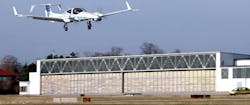Optical "autopilot" lands aircraft with camera-only reference system

Automatic landings have long been standard procedure for commercial aircraft. While major airports have the infrastructure necessary to ensure the safe navigation of the aircraft, this is usually not the case at smaller airports. Researchers at the Technical University of Munich (TUM; Munich, Germany) and their project partners have now demonstrated a completely automatic landing with vision-assisted navigation that functions properly without the need for ground-based systems.
In the project "C2Land", supported by the German federal government, TUM researchers have partnered with Technische Universität Braunschweig to develop a landing system which lets smaller aircraft land without assistance from ground-based systems.
The autopilot uses GPS signals to navigate. The problem: GPS signals are susceptible to measurement inaccuracies, for example due to atmospheric disturbances. The GPS receiver in the aircraft can't always reliably detect such interferences. As a result, current GPS approach procedures require the pilots to take over control at an altitude of no less than 60 meters and land the aircraft manually.
In order to make completely automated landings possible, the TU Braunschweig team designed an optical reference system described in various published works and presentations: A camera in the normal visible range and an infrared camera that can also provide data under conditions with poor visibility. The researchers developed custom-tailored image processing software that lets the system determine where the aircraft is relative to the runway based on the camera data it receives.
In order to make automatic landings possible, additional functions were integrated in the software, such as comparison of data from the cameras with GPS signals, calculation of a virtual glide path for the landing approach as well as flight control for various phases of the approach.
In late May the team was able to watch as the research aircraft made a completely automatic landing at the Diamond Aircraft airfield. Test pilot Thomas Wimmer is completely convinced by the landing system: "The cameras already recognize the runway at a great distance from the airport. The system then guides the aircraft through the landing approach on a completely automatic basis and lands it precisely on the runway's centerline."
SOURCE: Technical University of Munich (TUM); https://www.tum.de/nc/en/about-tum/news/press-releases/details/35556/
About the Author

Gail Overton
Senior Editor (2004-2020)
Gail has more than 30 years of engineering, marketing, product management, and editorial experience in the photonics and optical communications industry. Before joining the staff at Laser Focus World in 2004, she held many product management and product marketing roles in the fiber-optics industry, most notably at Hughes (El Segundo, CA), GTE Labs (Waltham, MA), Corning (Corning, NY), Photon Kinetics (Beaverton, OR), and Newport Corporation (Irvine, CA). During her marketing career, Gail published articles in WDM Solutions and Sensors magazine and traveled internationally to conduct product and sales training. Gail received her BS degree in physics, with an emphasis in optics, from San Diego State University in San Diego, CA in May 1986.